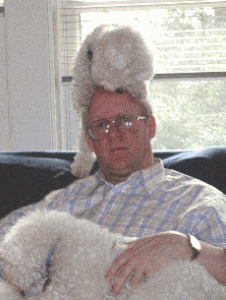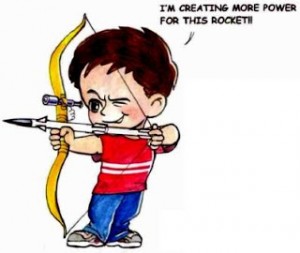Meet Dr. David Pensak, a man who is in the creative prime of his life in his 60s and who has some pretty interesting ideas on how we need to reset the education switch globally. Why should we be listening to him? Not because he is a graduate of Princeton where he studied chemistry. Not because he has a PhD from Harvard and was a post-doctoral fellow at that school. Not because his thesis was on “Computer Aided Design of Complex Organic Synthesis.” And not because he is affiliated today with University of Delaware, George Washington University and Drexel and lists many interests on his curriculum vitae including computer security and artificial intelligence. Not because he has written a book Innovation for Underdogs.

And Dr. Pensak is just getting started in identifying even more uses for his invention. When we spoke over Skype as Hurricane Sandy was bearing down on the Delaware and New Jersey shore a couple of weeks ago, he shared the inspiration behind his invention of a new coffee lid to make the beverage taste better.
Dr. Pensak is a tea drinker, but his wife loves coffee. And not just an occasional cup. As he puts it, “you see my wife is a coffee addict. And she constantly carries coffee with her everywhere she drives. But coffee in a travel mug can be terrible.” Dr. Pensak, happily married and wanting to please his wife, went about experimenting with all kinds of different mugs – plastic, polythermal, stainless steel, you name it. But none of the containers made coffee taste better. What he knew from his background in chemistry was the relationship between taste and smell, and, therefore, hypothesized that if he could make the aroma come out that would alter travel mug coffee’s taste. To do this he tested different membrane technologies, finally discovering an aroma-friendly one that could be manufactured into a travel mug lid. Cost of the prototype — $12. Results – coffee that tastes way better.
In 2011 he filed a patent for his membrane lid technology and formed a new business, The Vaporiety Company. That business was named one of the most promising start up companies on the planet in the fall of last year by the Kauffman Foundation, a Kansas City-based not-for-profit that focuses on helping new business startups encouraging entrepreneurship, innovation and commercialization.
As we spoke Dr. Pensak talked about the motivation behind invention and innovation. His own personal motivator in creating the Vaporiety coffee lid was his wife’s offer to give him a case of Bordeaux wine, what he called a “carrot” approach. I asked him to define “innovation” and “invention.” And that got us on to the topic of what we are not teaching young people today – how to think in circular fashion rather than linearly.
Innovation comes out of need and dissatisfaction. If something isn’t right, innovators find a way to make it better.
Invention comes out of curiosity and is often driven by necessity. Invention is about pushing the boundaries beyond conventional wisdom, countering the established way of doing things by creating something entirely new.
The Department of Education in the United States has launched an “Educate to Innovate” program focused on science, technology, engineering and mathematics and going by the acronym STEM. But if STEM is about rote learning and test scores will it create a new generation of innovators and inventors? Dr. Pensak thinks not. He believes current education methodology is causing brain atrophy in our youth.
I asked him what he meant by “atrophy.” He talked about education as an industrial process rooted in 19th century practices. That classroom education today continues to teach students to follow directions and orders. That it discourages risk taking. To illustrate he told me a story about posing a problem to students demonstrating the plasticity of young minds:
The Problem: Golfers, particularly bad ones, spend more time on golf courses looking for lost balls than actually playing the game. That includes me and I play on public courses. On a busy course, searching for balls slows everybody down. That means fewer foursomes can play and that means golf courses makes less money. So creating a golf ball that can be found easily would be a good thing.
Conventional Solution: A high tech golf ball that uses defined radio frequencies to broadcast location plus a device that the golfer would use to zero in on the radio frequency of each lost ball.
The Problem with the Solution: Cost of manufacturing, availability of radio frequencies that can be used to tag golf balls in the millions. Disruption in play would still occur as golfers would still be the ones looking.
A Student’s Suggestion: Sometimes we can learn by observing how other species locate things and come up with a simple solution. Golf courses should use male dogs to retrieve lost balls using the dog’s strong sense of smell. A golf ball coating would contain a female pheromone. For male dogs on the course finding lost balls would be a piece of cake. The end result would see searches for lost ball bottlenecks disappear and more revenue from more players on the course.
Dr. Pensak isn’t the only educator who sees circularity as an important problem solving tool. Sir Ken Robinson has spoken at several TED conferences on the subject of learning. He would appreciate this student’s creative solution because in his book Out of Our Minds: Learning to be Creative, he argues that current educational practice creates linear thinkers, capable of following direction, but seldom challenged to be inventive. Both he and Dr. Pensak believe education needs to be designed for a right-brain economy, capable of inspiring individual creativity. This type of education goes beyond deductive reasoning, embraces those who think visually, or through sound and movement. Robinson argues that most adults consider themselves not creative, whereas all children consider themselves very creative. It is our education system today that turns the creative switch off in so many young people. Dr. Pensak argues that our society exhibits a reluctance to take risk because our educational systems. And that is the challenge he is addressing in mentorship programs at the three schools to which he is affiliated.
We talked about the new paradigm of the 21st century – constant, blinding-fast change, change being driven by the growth in world population, and by advances in information technology. We talked about how to change education to bring the inventive child into the adult world where they can become the creative, inventive adult?
Conventional education focuses on what is useful in the competitive world and what is not. Useful subjects are mathematics and language. Useless subjects are the humanities and the arts. The No Child Left Behind program, implemented in the United States to fund improved test scores, focuses almost exclusively on measuring improvements in numeracy and literacy. But the truth is the subjects, the delivery, and the method of assessment, does not contribute much to an inventive society. Children need to do subjects that get them in touch with the visual, with movement and with sound. Children need the stimuli to express their creativity through experimentation, through failing and trying again. Assessment cannot inhibit progress and switch off a child’s natural creativity. That’s how you create a plastic, malleable mind that views a problem from many angles and comes up with creative solutions like our golf ball example. After all, Albert Einstein, when stumped by a mathematical and physics challenge, would play his violin. He attributed his theory of relativity to those moments when he would sit with the violin playing classical music.
Dr. Pensak continues to exhibit the plastic mind that we all have as children. He hasn’t stopped being inventive. I asked him what else is up his sleeve. He gave me a hint of just a few of the many projects he has on the go. They include:
- Developing a dry geothermal technology for use in the Rift Valley region of Sub-Saharan Africa.
- Examining electric eel physiology to develop new ways to create renewable energy.
- Harnessing plant photosynthesis to create new sources of energy.
- A project in Brazil creating building materials from the residue from sugar cane burning and combining the carbon with foam to make construction material stronger than rebar.
- Recovering diapers from landfill and using them as a source for generating biogas.
A remarkable list of inventions and innovation from a remarkable man.


















“Why should we be listening to him? Not because he is a graduate of Princeton where he studied chemistry. Not because he has a PhD from Harvard and was a post-doctoral fellow at that school. Not because his thesis was on “Computer Aided Design of Complex Organic Synthesis.” And not because he is affiliated today with University of Delaware, George Washington University and Drexler and lists many interests on his curriculum vitae including computer security and artificial intelligence. Not because he has written a book Innovation for Underdogs.”
Maybe we should listen to him because he thinks it’s an innovative idea to be photographed wearing a dog or cat for a hat. His next book could well be titled “Innovation for Overdogs.”
I’m guessing Professor Boltzmann got it mostly correct when he called Einstein a “lazy dog.” But if Einstein had not been such a lazy dog, he probably wouldn’t have thought so deeply about the implications of the finite speed of fundamental force propagation. It’s probably a mistake to take seriously anything Einstein might have said about his personal inspirations. It seems to be a historical fact that Einstein implausibly denied he knew of the Michelson-Morley interferometer experiment results at the time he published his Nobel Prize wining early papers on Brownian motion and photoelectric effects and first thought of the concepts of special relativity (Likely the most famous experiment in the history of theoretical physics, and published over a decade before Einstein published.). The true principal progenitor of special relativity seems to have been Hendrik Lorentz, the exact opposite of a “lazy dog, to whom Einstein, while basking in international scientific renown, publicly gave only scant credit. Not until Einstein was delivering his 1928 graveside eulugy to Lorentz did Einstein say it plainly to the world that Lorentz was the most sublime mind he had ever encountered. After Lorentz was properly buried, Einstein wrote, “The enormous significance of his work consisted therein, that it forms the basis for the theory of atoms and for the general and special theories of relativity. The special theory was a more detailed expose of those concepts which are found in Lorentz’s research of 1895…”
“In 1905, Einstein would use many of the concepts, mathematical tools and results discussed to write his paper entitled “On the Electrodynamics of Moving Bodies”,known today as the theory of special relativity. Because Lorentz laid the fundamentals for the work by Einstein, this theory was originally called the Lorentz-Einstein theory. Einstein never resisted the dropping of Lorentz’s name from general reference to “his” theory. The historical fact is that the majority of “innovative” thought behind special relativity came from a number of “hard working dogs” named something other than Einstein.
The Wiki article, http://en.wikipedia.org/wiki/Hendrik_Lorentz provides a good general overview of who and how relativity developed. Had Einstein’s “innovations,” been completely lost, we still would have obtained relativity theory, already in infancy when Einstein was still at university, but it would have been more properly credited to Lorentz et al., and it would have been presented in a much less mystical context.
Einstein built his concepts on the shoulders of those who preceded him. I appreciate the insights on Lorentz. The point of the Einstein story in my article was to show that creativity is both a right and left brain phenomenon and that developing the whole brain rather than the left brain alone (the mathematics side) is a critical component in creating innovators. As for the rhetorical flourish of my opening statement, a conversation with David Pensak is a most enjoyable, and down-to-earth experience, credentials notwithstanding. I have talked to many academics in the past who found it difficult to express what they know in terms that were generally understood but David Pensak is not one of them. The picture with the dogs comes from his blog site and I believe was inspired by a picture taken of him sleeping one day with the dogs deciding to join him for a nap, several below and one on top. Being an owner of miniature red poodle, and a shameless lover of dogs of all kinds, I couldn’t resist using the picture for the story.
Here’s a great example of a man who has maintained a genuine sense of wonder. Actually, two men as both Dr. Pensak and Mr. Rosen bring a zest to their explorations of our present and future. I hope my two sons will escape the constricting realities of the current educational system and learn to pursue the curious and inexplicable. Thanks for sharing this story.